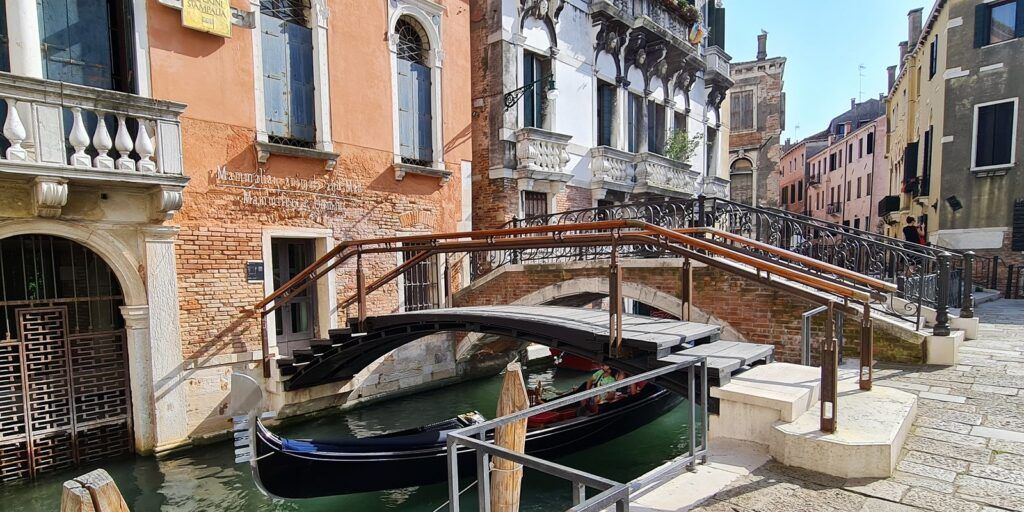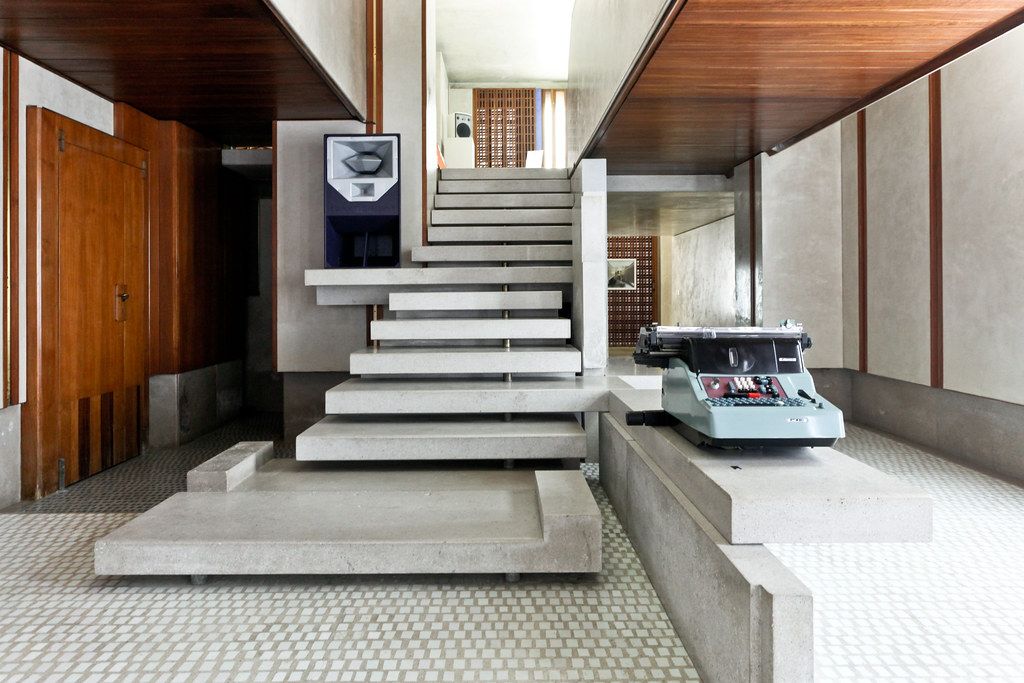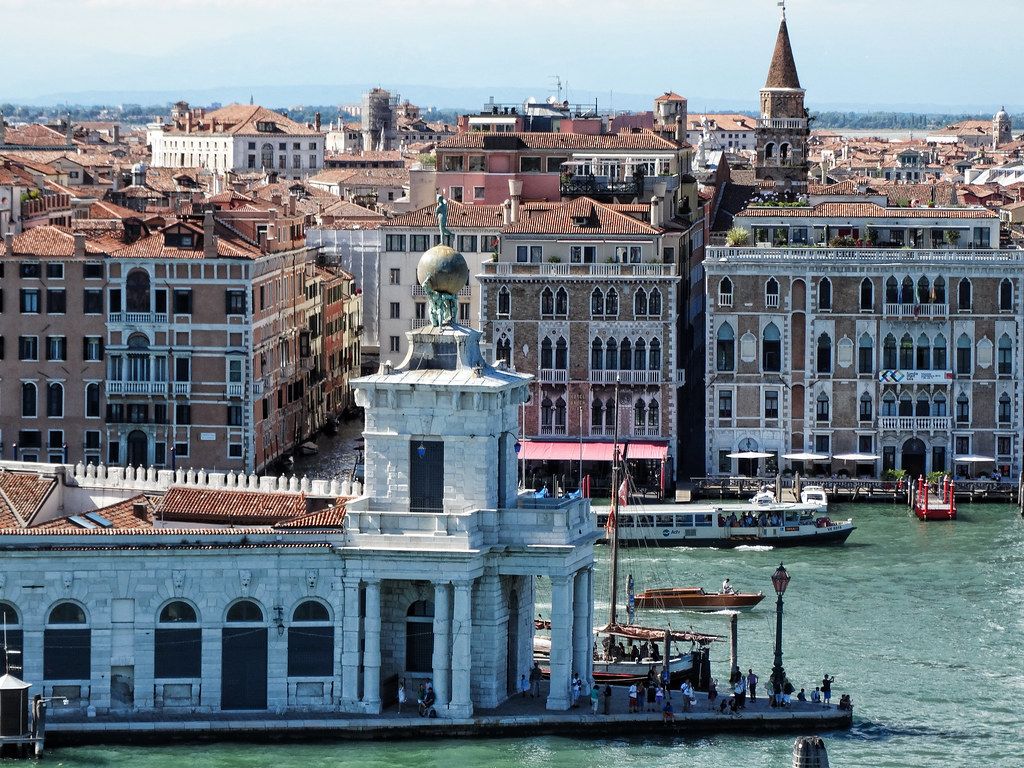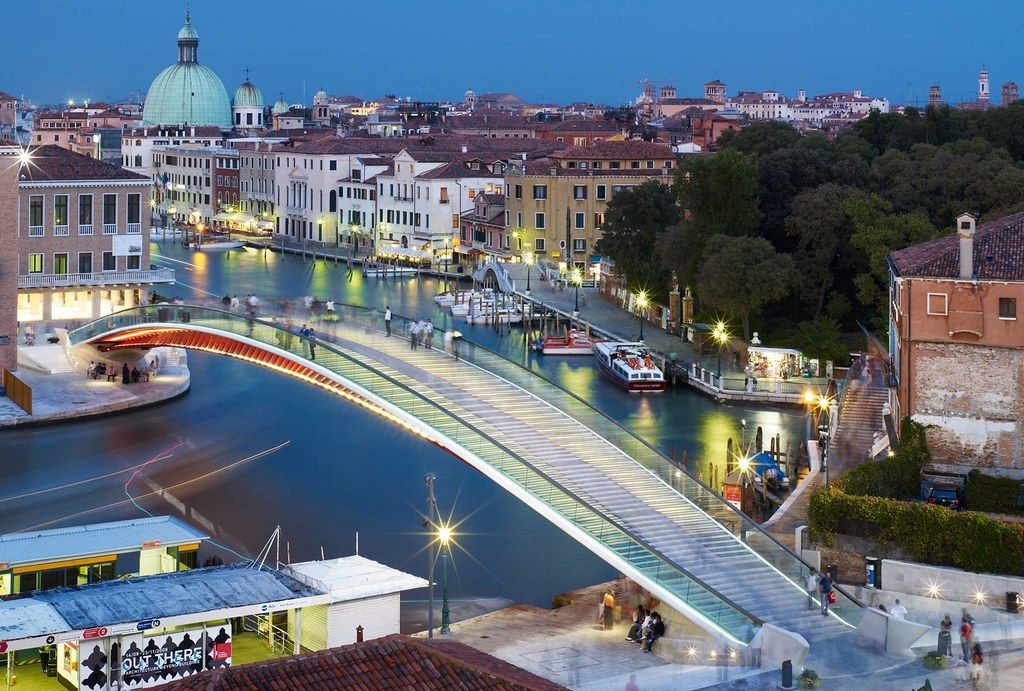Finding examples of contemporary architecture in Venice doesn’t seem to be so simple. Venice is a jewel nestled in the lagoon where every brick, stone, and slab of marble tells stories that could entertain us for hours. This is the main reason why this city deserves to be preserved. Because of its layout (unlike other historically rich cities like Rome and Florence), Venice doesn’t have large spaces to expand further, except by moving to the mainland outskirts.

It is natural, then, that the combination of “art and architecture” in Venice doesn’t bring to mind futuristic structures and the names of great contemporary architects but rather evokes the smooth forms of Canova’s statues, the brushstrokes of Tiepolo, Bellini, and Tiziano. The artworks of these artists who lived in the golden age of the Venetian Republic are still preserved in luxuriant palaces like the Correr Museum, Cà Rezzonico, or in the luxurious halls of the Doge’s Palace.
Contemporary architecture in Venice from the 1950s to the present
Famous names in architecture from the 1950s-’60s to the present have left their mark, putting their signature on innovative projects that have brought, sometimes with criticism, a breath of freshness among the alleys and fields of Venice. Below, we will take you to discover the contemporary architecture of Venice. You will find a list of them in chronological order, from the oldest to the most recent.
Querini Stampalia Foundation
The Querini Stampalia Foundation is a cultural foundation in Venice that is the legacy of Giovanni Querini Stampalia, who died without heirs in the second half of the 19th century. Nowadays, it is home to a library and a museum where you can find temporary exhibitions, particularly of contemporary art. The headquarters of the foundation is located in the Castello district, in Campo Santa Maria Formosa, and it is precisely its headquarters that is one of the interesting inspirations of contemporary architecture in Venice.
Between 1961 and 1963, Architect Carlo Scarpa was responsible for the restructuring of part of the ground floor and the garden to make them more functional to the new needs of the Foundation and to restore them following the damage caused by time and high water. Those who visit the Querini Stampalia Foundation will find the mark left by Carlo Scarpa in the access bridge (entrance to Campiello Querini), in the staircase to the library, in the Gino Luzzato exhibition hall (where the original portego was located), and in the garden.

The architect’s signature is recognizable in the simple lines, geometries, and the use of materials such as concrete (which you will notice if you have had the opportunity to visit his other works, such as Tomba Brion or the Canovian Gipsoteca). At the same time, Scarpa doesn’t forget to create a material and conceptual continuity between the building and the city. He does this by using elements that have always characterized it: Istrian stone, marble, wood from the entrance bridge, and glass tiles in the water basin in the garden.
There are two aspects that we find most interesting about this place. The first concerns the water, and the second is the garden of the Foundation. The architect allows water (the primary element of Venice, its charm, and its ruin) to enter the building. A system of stone steps defends but at the same time allows controlled access of the lagoon to the ground floor. The garden of the Foundation instead has, in our eyes, the charm it shares with much of the Venetian gardens. It reminds us of the atmospheres narrated in the book “The Secret Garden” by Burnett. It is possible to visit the Querini Stampalia Foundation by paying an entrance ticket that gives access to the Museum, the Scarpa Area, and the Exhibition Areas.
Olivetti Showroom in Venice
We move to Piazza San Marco following the inspiration of Architect Carlo Scarpa. Overlooking this amazing square in Venice is the Olivetti Showroom, a small space in the shade of the Procuratie Vecchie, which Adriano Olivetti himself strongly wanted as a showcase for his products and whose interior design was entrusted to Carlo Scarpa in 1957. Despite its small size, the spaces have been maximized. Light comes from the large windows on the two sides, while the high ceilings have allowed the creation of a second floor reachable by a large central staircase with suspended steps designed by Scarpa himself.

Inside, white marble prevails with inserts of Murano glass in blue, yellow, and red colors. The furnishings are simple and essential, and the intention seems to be to let the exhibited products be the protagonists. You will see beautiful Olivetti typewriters that have now become true design objects 100% Made in Italy. The Olivetti Showroom is open to the public and visitable for a fee every day except Monday. The property belongs to Assicurazioni Generali, which entrusted management to FAI after a restoration in 2011 that restored the store to its former glory.
Punta della Dogana
Punta della Dogana in Venice is located in one of our favorite areas which is the Dorsoduro district. It is a triangle of land that separates the waters of the Grand Canal from those of the Giudecca Canal. It is a point of arrival and departure for goods, in the ancient city of the doge. In 2009, Punta della Dogana opened its doors as the Center for Contemporary Art – François Pinault Foundation after an important restoration project by the architect Tadao Ando.

The Japanese architect, known for his modern projects and the use of innovative materials, before starting work made a careful study of the location, its role in the history of the city, and the best way to reconcile history and innovation through architecture. This involved the complete recovery of the original external facades, so much so that from the outside, it is difficult to imagine the modernity enclosed within.
Upon entering, the mixture of past and future immediately catches the eye. The brick walls alternate with those in concrete, the half-moon windows offer beautiful views of the surrounding cityscape, and modern art finds its ideal context in the spacious, airy, and bright rooms that present elements of yesterday and today. Punta della Dogana is open every day except Tuesday for both locals and tourists.
Constitution Bridge
The Constitution Bridge, better known as Calatrava Bridge from the name of the architect who designed it, is a mixed blessing for the citizens of Venice. It is the fourth bridge over the Grand Canal after the Rialto Bridge, the Scalzi Bridge, and the Accademia Bridge. This modern bridge was inaugurated in 2008 as a project by the Spanish architect Santiago Calatrava. The construction, with its glass and steel structure, connects the Santa Lucia Station area to Piazzale Roma.

Since its inauguration, it has been the subject of heavy criticism from the public for the high construction costs and the associated problems (from the operation of the gondola lift for disabled people to the material itself used, glass, considered impractical and even dangerous in a city as humid as Venice). Criticism aside, Calatrava’s Constitution Bridge rightfully enters the list of contemporary architecture in Venice.
Fondaco dei Tedeschi
One of the most recent restoration projects in Venice is the Fondaco dei Tedeschi, located at the foot of the Rialto Bridge. This large rectangular-shaped building, built in the 1200s, served various functions over the past. Initially, it was used as a place of trade and storage of goods by merchants from Northern Europe during the Republic. At the time of Napoleon, it became a customs house, and from the WWII period to the present day, it has been the headquarters of the post office.

Purchased by the Benetton family and inaugurated in 2016, the restoration of the building was entrusted to the OMA architecture studio of the Dutch architect Rem Koolhaas to convert it into a luxury shopping center in the heart of the city. The building, especially externally but also internally, has retained much of its original structure. When entering, you find yourself in the internal courtyard where, among the tables of the modern bar, the ancient wellhead is still present.
From here, it’s impossible not to look up in amazement and observe the three floors of terraces with arches that surround all four sides of the courtyard, from which you can access the shops of famous brands that were once warehouses for goods. The roof of the courtyard is a steel and glass structure with a wooden terrace, which is accessible for free but by reservation through the website. From there, you can enjoy incredible views of the Grand Canal and the city. Therefore, we recommend reserving your visit in advance so that you can visit both the interior and the terrace of Fondaco dei Tedeschi.
Check out more articles about Italy:
- The best of Venice in 24 hours
- Venice in one day from Santa Lucia station
- Things to do on New Year’s Eve in Venice
- Why you should visit the Jewish ghetto in Venice
- Best pastry shops in Venice
- How to get to Venice?
- What to see in Carole?
- Local markets of Sicily
- Best budget-friendly places to stay on Amalfi Coast
- Best beaches in Elba Island
- Things to do on Lake Como

